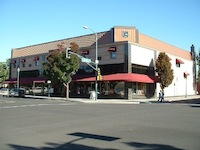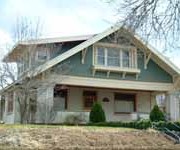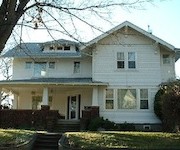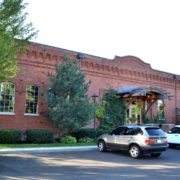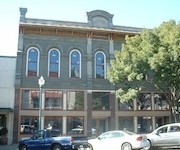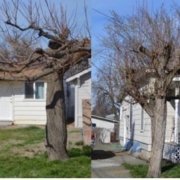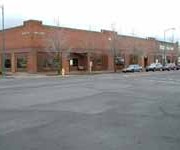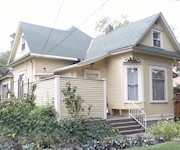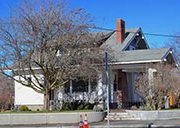History of 102 East Main Street, Walla Walla, WA – Sutherland Building
Property Description:
Beginning at a point on the Southeasterly line of East Main Street in the City of Walla Walla, Washington, which is 202 feet Southwesterly (measured on said Southeasterly line of East Main Street) from the point of intersection of said Southeasterly line of East Main Street with the Westerly line of Spokane Street, as said Spokane Street is opened and established; thence continue Southwesterly and on the Southeasterly line of East Main Street, 105 feet and five inches; thence Southeasterly at right angles to said line of East Main Street to the center line of Mill Creek, as the same is now bulkheaded and established; thence Northeasterly and along said center line of Mill Creek to a point therein which a line drawn through THE POINT OF BEGINNING and at right angles to said Southeasterly line of Main Street would intersect; thence Northwesterly in a straight line to THE POINT OF BEGINNING.
TOGETHER WITH an undivided one-half interest in and to the West one foot of the tract adjoining said premises to the East.
Title History:
Walla Walla was originally laid out by surveyor H.H. Chase in 1859, even before its formal incorporation as a city in 1862, as a one-quarter mile square oriented N-S, E-W and with its eastern side centered on the point where Main Street crossed Mill Creek (at roughly the point where it does now). To this original area, additional parcels were annexed from time to time, usually named after the land owner of record at the time the additions were made.
This property is part of the oldest U.S. Patent in Walla Walla. On September 10, 1861 Andrew J. Cain and Cornelius Kelly filed a patent on 160 acres under the Script Warrant Act of 1855 northeast of the original City of Walla Walla town site. During 1862, A. J. Cain surveyed Cain’s Addition to the City (this survey was rerecorded on May 11, 1865, following a disastrous fire which destroyed most of the county’s earlier records).
A. J. Cain was an early financier of The Walla Walla Statesman newspaper; in 1868 he was elected on the Democratic ticket as prosecuting attorney of Walla Walla County. He later moved to Dayton and in September 1874 began publication of the Dayton News, a weekly Democratic newspaper. He became known as the “Father of Columbia County” as a result of his leading role in the formation of that county. His widow, Mrs. E. R. Cain, lived at the corner of Second and Poplar Streets in the first City Directory in 1881.
On May 3, 1862 A. J. and Emma R. Cain signed a quit claim deed including this property to Way and Bush for $300. The property was described as “where the South Side of Nez Perce Street in Cain’s Addition to the town of Walla Walla intersects the south line of said Cain’s land claim then due East along said South line of the said Cain’s land claim to the middle channel of Mill Creek thence up the middle of the channel of Mill Creek to a point by George E. Cole’s property thence on the Northerly direction along said Cole’s line to Nez Perce or Main Street thence along the line of said street to the place of beginning containing 1.5 acres more or less.” Husan Way and Charles S. Bush were involved in many local land transactions, usually using only their last names. On July 11, 1862 they filed a lien in the amount of $585.03 against J. W. Seaman on the construction of a 16 x 21 foot dwelling with one story, porch and 10 x 16 foot kitchen on this property. On October 21, 1862 Seaman was the defendant in a district court case with Way and Bush. On January 9, 1863 Husan Way sold “105.5 feet on Nez Perce Street to the center of Mill Creek next to the northwest corner of George Cole’s property” to Charles S. Bush. William S. Gilliam, Sheriff gave a Sheriff’s Deed including this property to Way and Bush on July 23, 1864 for $300. Mrs. N. J. Bush, widow, lived at 15 Spokane Street on the corner of Rose Street in 1881. On October 9, 1865 C. S. Bush and N. J. Bush sold this property to John Dovell and E. H. Massam for $500. John Dovell ran a planing mill and furniture factory across Main Street at #117-129 in 1881. On January 1, 1868 John and Margaret Dovell sold two parcels to Edward H. Massam for $300. Edward H. Massam was born in Lower Canada in 1837, came to Walla Walla in 1861, was married to Miss O’Brian by Father Brouillet in 1863 and had a daughter born in 1864. This area of town was re-platted as Cain’s Addition in 1876. In 1904 this property was assessed to help purchase land for the opening of Spokane Street as well as the concrete embankments of Mill Creek from East Main to Palouse Street. Massam also had to help pay for the improvement of Alder Street (paving, curbs, gutters and improvements) from “East Street” to Park Street. In addition to his wagon making business Massam owned 320 acres of farm land. Eliza Massam died on December 4, 1909 and her husband sold this property to P. M. Winans for a stated amount of $10 on October 9, 1912. On the next day P. M. and Rose M. Winans sold it to G. H. Sutherland Co. George and Lydia Sutherland lived at 420 South Second in 1914 along with Louis Sutherland. Lydia was on the executive committee for the 1914 Pageant in May (Bennett Vol. 2, page 179). In 1916-1917 Louis and Lulu Sutherland lived at 817 S. Palouse. On June 26, 1916 H. B. Strong died and Edna Stone was appointed his estate administrator. Edna Stone subsequently acquired title to an undivided 1/2 interest in a one foot wide strip of property back to Mill Creek on the east side of this lot, which she transferred to Sutherland in 1920. On February 6, 1919 Sutherland signed an agreement with A. M. Jensen establishing the boundary on the west side of this property.
George Sutherland died in 1927 and Louis died in 1932. On July 29, 1936 Lulu Sutherland, President of G. H. Sutherland Co., signed a deed transferring this property to John G. and Martha V. Kelly. The Kellys were a prominent Walla Walla family. He had purchased the Walla Walla Bulletin in 1910. He “snared funding” of $150,000 to build the Walla Walla armory in 1920 . In order to get the money a National Guard unit was formed and a promise made to house two of the four big guns used by the 146th Artillery Unit in France in World War I. The guns had been nicknamed Blanche, Jennie, Cleopatra and Lily. Today two of the guns are being restored by the Loose Cannon Committee. He was also instrumental in starting the food processing industry with the Walla Walla Canning Co. in 1932. Mrs. Kelly was involved in many civic affairs. In 1937 the Kellys signed an Assignment of Lease agreement with Washington Mutual Savings Bank for their lease with the Sears Roebuck Co. to occupy #104-110 with their retail store and #112-114 with their warehouse (where the former Public Market had been). In January 1938 Kelly signed a Commission Agreement to pay H. W. Dye $3672 for securing the Sears’ lease. In December 1942 John and Martha Kelly transferred an undivided 1/10th interest in this property to their daughter Laura E. Carey and her husband Arthur A. Carey. At the same time they transferred an undivided 1/2 interest in the building and rents to their son Norman M. and his wife Catherine B. Kelly. In December 1945 Catherine B. Kelly signed a quit claim deed giving all her interest in this property and rentals to her husband Norman, prior to her divorce from him in 1947. In 1948 the Walla Walla County Mill Creek Flood Control District filed suit against property owners adjacent to Mill Creek to “quiet titles” to land within the Mill Creek channel. In 1958 Catherine Adams and Adolph Schwarz signed an agreement with the Kelly family to establish the center line of Mill Creek as boundary between their respective properties. In 1959 John and Martha Kelly signed quit claim deeds giving this property to Donald and Virginia Kelly Sherwood, Emma Jane Miller and Roland E. Miller Estate, and Arthur A. and Laura Kelly Carey. In 1960 Norman Miller Kelly quit claimed all his undivided half interest in this property to his father, John Kelly. The next day John and Martha Kelly transferred all interest in their undivided 6/10th of the property to the Walla Walla Union Bulletin Foundation. In 1965 Art and Laura Carey(2/10th share), Don and Virginia Sherwood (1/10th share) and Emma Jane Miller Brattain (1/10th share) did the same. On September 19,1990 the Marcus Whitman Foundation (title originally acquired as Walla Walla Union Bulletin) filed a Notice of Real Estate Contract on this property with Gary Dean and Susan Joyce Palmer for $125,233.04. This contract was paid and a warranty deed given to the Palmers in 1999.
On the portion of the property east of the Sutherland Building on January 27, 1992 Bill Jackson, Sheriff gave a Sheriff’s Deed under Foreclosure of Mortgage to Building Dynamics Inc. against Samuel and Shirley Kralman for $47,204.68. On June 30, 1993 the City of Walla Walla gave a Deed of Right of Use Land for Public Recreation Purpose to the State of Washington. This was formerly a mini-mall and is the current location of Heritage Park.
On October 3, 2003 the Palmers gave a Memorandum of Lease plus Grant of Right of First Refusal to Buy to Charles Matthew and Tanja N. Seeliger. A Notice of Trustee’s Sale on February 6, 2004 was filed showing $222,569.82 owed. On March 15, 2004 Terry R. Nealey, Bankruptcy Trustee, gave a Trustee’s Deed to Matthew and Tanja N. Seeliger for $495,000.
Occupant History:
The first recorded structure at this location was the 16 x 21 foot one-story dwelling with porch and kitchen which was subject to a lien in 1862. In the oldest city directory in 1881 Edward H. Massam, wagon maker, listed his residence as 104 E. Main. His shop where he made wagons was located at 48 E. Main Street. The oldest fire map in 1888 shows a simple rectangular structure on this property between Schwabacher Bro’s Agr. Imp. W. Ho. on the east and a feed yard on the west. On the 1890 and 1894 fire maps there is a substantial residence at 104 with another residence on each side plus Baumeister’s Livery to the west about where the Liberty Theater is today and an “agricultural implements shed” on the east. On the 1905 fire map there were just two residences here, with the residence to the east of Massam’s house replaced by McBride Co’s Livery Feed & Boarding. Massams continued to live on this property through 1905, by which time the Die Brucke Building has been completed at First and Main. By 1908 Massam and his wife had moved to 121 E. Rose Street. Eliza Massam died in 1909.
In the 1911-1912 City Directory the G. H. Sutherland Pipe and Fittings, Plumbing and Heating, was located at 129 E. Alder. By 1912-1913 they had moved to 108 E. Main. There is a photo of Main Street taken from the top of the Baker Boyer Bank about this time (Bennett, Vol. 2, Page 214) which shows the Die Brucke Building and the theater with no buildings or street between it and the “Everything Electric” sign on this building. By 1929-1930 George Sutherland had died and Louis was president of the company. In 1931 #102-104 was vacant; #106 was the Electric Supply and Fixture Company and #108 was G. H. Sutherland Co. In 1933 and 1935 the Mutual Piggly Wiggly Grocery was in #102 while #106 and #108 remained the same. In 1937 #102-110 were all vacant. In 1939 this space was leased to Sears Roebuck Co with Robert Hubbard, manager. Sears had previously been located across Main Street at #109. Sears continued to occupy this site until 1989 when they moved to the Blue Mountain Mall. In 1991 Derby Electric opened business here. The Seeligers moved their Sew and Vac business to this location in 2004 from their prior place of business at 15 East Main Street.
Construction of the Building:
The Walla Walla County Assessor lists the construction date for this building as 1902. However the Whitman College Archives history index reports that the Sutherland Building on east Main was to be built by Contractor J. A. McLean with a bid of $14,436 in December 1912 following their purchase of the property in October 1912. In 1913 Sutherland had a permit to “remodel store front” for $2475 at 104 E. Main. In 1917 he took out a $50 permit to have an “iron shed” built by Charles Halter. Colville Street was not completed on the west side of this property until 1919 when A. M. Jensen told the city he would build a new building on the property to the west of this one if the city would construct a bridge across Mill Creek and complete Colville Street (Bennett Vol. 3, page 6). Since construction on this substantial building began in December of 1912, it was most likely completed in the spring of 1913, so a date of 1913 should be used for the completion of the building.
References:
Andres, Penny, Walla Walla, Her Historic Homes, Vol. II, 1993.
Bennett, Robert A., Walla Walla Portrait of a Western Town 1804-1899, Pioneer Press, Walla Walla, 1980.
Bennett, Robert A., Walla Walla A Town Built to be a City 1900-1919, Pioneer Press, Walla Walla, 1982.
Bennett, Robert A., A Nice Place to Raise a Family 1920-1949, Pioneer Press, Walla Walla, 1988
Lyman, Professor W.D., An Illustrated History of Walla Walla County 1901.
Sanborn Fire Maps: 1884-1905 (with updates until 1950)..
Walla Walla City Directories: 1880-present (various publishers–not all years).
Whitman College Penrose Library Archives.
Mary E. Meeker Walla Walla 2020 Research Service PO Box 1222, Walla Walla WA 99362 September, 2004
